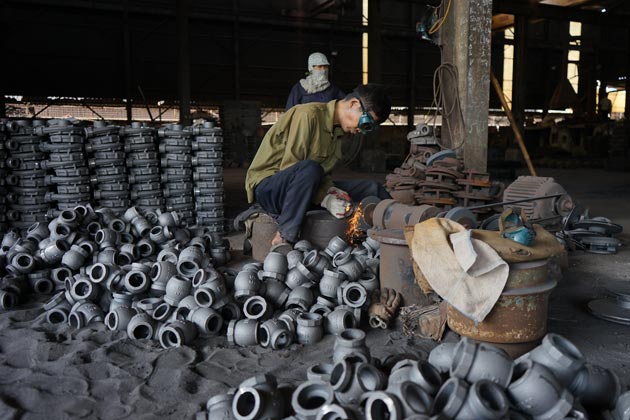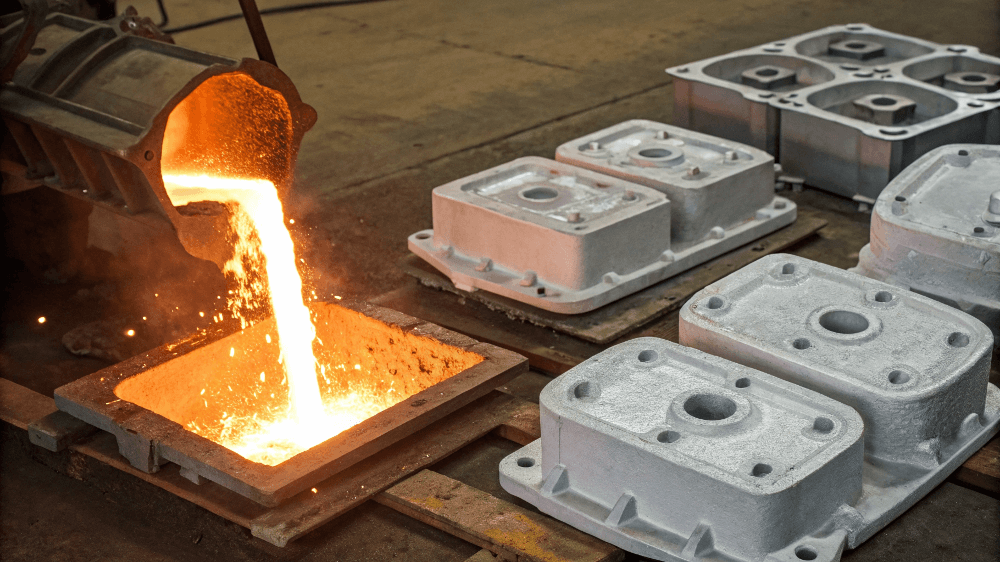Exactly How Aluminum Foundry Contributes to Improvements in Aerospace Design
Aluminum foundries are essential to developments in aerospace design. They create lightweight, high-strength parts that are essential for modern airplane. Through advanced spreading techniques, these foundries produce complicated geometries that enhance structural honesty. In addition, the development of exceptional Aluminum alloys supports the market's emphasis on gas effectiveness and sustainability. However, obstacles remain in the manufacturing procedure. Comprehending these variables discloses the extensive impact of Aluminum on aeronautics's future.
The Value of Lightweight Materials in Aerospace Layout
As the aerospace market remains to progress, the significance of lightweight products ends up being progressively noticeable. The need for performance and sustainability drives engineers to prioritize using products that reduce total weight without jeopardizing architectural integrity. Light-weight materials, especially Aluminum, play a vital duty in boosting gas performance, boosting haul capability, and boosting the general efficiency of airplane.
Additionally, the combination of these materials enables innovative designs, enabling makers to develop more aerodynamic shapes that can hold up against severe problems. The reduction in weight not just decreases functional expenses however also adds to a lowered environmental impact, aligning with global initiatives toward sustainability in aviation.
Advanced Spreading Techniques in Aluminum Foundries
Advanced spreading techniques in Aluminum shops play an important role in aerospace engineering by making it possible for the manufacturing of light-weight and precise components. Technologies in mold and mildew layout and accuracy casting processes are vital in accomplishing ideal efficiency and architectural stability. In addition, the growth of light-weight alloys improves the total effectiveness and effectiveness of aerospace applications.
Cutting-edge Mold And Mildew Layout
Innovative mold style plays a necessary function in the effectiveness and efficiency of Aluminum shops, particularly within the aerospace field. By leveraging innovative products and methods, modern-day mold and mildews can be crafted to endure heats and pressures, ensuring peak performance throughout the spreading procedure. These layouts frequently include complex geometries that permit the manufacturing of light-weight yet structurally sound components, crucial for aerospace applications. Furthermore, the usage of computer-aided style (CAD) software promotes accurate modeling, allowing shops to imitate and refine mold styles before physical production begins. This not only improves the high quality of cast components yet additionally minimizes waste and preparation, bring about significant expense financial savings. Overall, innovative mold and mildew style is a foundation of progression in Aluminum Foundry modern technology for aerospace engineering.
Accuracy Casting Processes
The performance of cutting-edge mold styles seamlessly integrates with precision spreading processes, which are crucial for creating top quality Aluminum components in aerospace engineering. These procedures, including sand spreading, pass away spreading, and financial investment casting, ensure the creation of complex geometries with limited tolerances. Advanced strategies like vacuum casting and stress pass away casting enhance the integrity and surface coating of the final products. Precision casting minimizes material waste while taking full advantage of the mechanical buildings of Aluminum, crucial for aerospace applications. Furthermore, employing real-time surveillance and progressed simulation devices during the casting process enables immediate modifications, bring about boosted quality assurance. Collectively, these precision casting procedures setting Aluminum shops at the leading edge of aerospace technology, sustaining the industry's demand for integrity and efficiency.
Light-weight Alloy Advancement
As aerospace designers look for to enhance fuel performance and performance, light-weight alloy development comes to be an important focus in Aluminum foundries. These shops employ sophisticated spreading methods to create alloys that provide premium strength-to-weight ratios. Developments in alloy composition, including the consolidation of aspects like lithium and magnesium, enable the production of materials that endure severe problems while lowering overall aircraft weight. Methods such as die casting and investment spreading facilitate the precision production of complicated forms, which are crucial for aerospace applications. Additionally, recurring research study intends to maximize these alloys for improved mechanical residential properties and enhanced resilience. By prioritizing light-weight alloy growth, Aluminum foundries significantly add to the development of aerospace design, paving the way for a lot more sustainable and efficient airplane styles.

Enhancing Structural Integrity Via Aluminum Elements
Aluminum elements use significant benefits in improving structural integrity within aerospace engineering. Their light-weight nature contributes to general performance while maintaining toughness, which is necessary for airplane efficiency. Furthermore, the anxiety resistance buildings of Aluminum help assure the durability and integrity of aerospace structures under different operational conditions.
Lightweight Material Advantages
While traditional products often compromise weight for toughness, making use of Aluminum components in aerospace design provides considerable advantages in architectural integrity. Aluminum's lightweight nature adds to general layout performance, enabling even more streamlined aircraft that take in less gas, thereby enhancing sustainability. The material's exceptional strength-to-weight proportion guarantees that elements preserve toughness without adding unnecessary mass. This quality promotes boosted efficiency and dexterity in trip, in addition to optimized payload capacities. Furthermore, Aluminum's resistance to deterioration extends the life expectancy of aerospace structures, decreasing maintenance prices and boosting safety and security. As makers significantly embrace Aluminum alloys, the aerospace market experiences a transformative change towards more efficient and reliable engineering options that prioritize both performance and ecological obligation.
Stress And Anxiety Resistance Qualities
Although various products possess distinct residential or commercial properties, Aluminum's exceptional stress resistance stands apart as a critical consider enhancing the structural honesty of aerospace parts. This resistance plays an essential role in guaranteeing that aircraft can stand up to numerous operational tensions, consisting of tiredness, influence, and environmental conditions. Aluminum alloys, particularly crafted for aerospace applications, show high tensile strength while preserving light-weight features, enabling engineers to create much more efficient frameworks - Aluminum Foundry. Additionally, the capacity of Aluminum to sustain cyclic loading without substantial contortion contributes to the long life and integrity of aerospace elements. As developments continue in Aluminum Foundry strategies, the growth of stress-resistant Aluminum components assures further enhancements in performance, safety and security, and performance across the aerospace market, solidifying Aluminum's function as a favored product in contemporary engineering
Fuel Effectiveness Improvements Driven by Aluminum Innovations
As the aerospace sector looks for to improve gas efficiency, cutting-edge uses of Aluminum have become a crucial service. Aluminum's light-weight nature notably reduces airplane weight, enabling lower fuel usage during trip. This reduction in weight is important, as even small declines can lead to significant renovations in total gas economic situation.
Advanced Aluminum alloys, created for boosted strength and longevity, make it possible for makers to develop parts that keep architectural integrity while decreasing mass - Aluminum Foundry. Additionally, the integration of Aluminum in airframes and engine parts assists in improved the rules of aerodynamics, adding to reduced drag and boosted efficiency
The fostering of Aluminum in aerospace not just fulfills the demand for fuel-efficient layout however also lines up with regulatory pressures for lower exhausts. As these innovations remain to advance, they play a considerable duty in setting brand-new criteria for click for info gas performance, ensuring that this content the aerospace industry can meet growing ecological and financial difficulties.

The Role of Aluminum in Sustainable Aeronautics Practices
The raising focus on lasting air travel techniques has actually placed Aluminum as a necessary product in the mission for greener airplane style. Known for its lightweight homes, Aluminum significantly lowers aircraft weight, bring about reduced gas intake and exhausts. Its recyclability better improves its sustainability profile, as Aluminum can be recycled forever without loss of quality. This particular sustains a circular economic situation within the air travel sector, lessening waste and resource deficiency.
Additionally, developments in Aluminum alloys have actually enhanced their toughness and deterioration resistance, permitting longer life span and lowered maintenance requirements. These developments promote the advancement of a lot more reliable aircraft frameworks, contributing to overall sustainability initiatives. Additionally, Aluminum's thermal conductivity plays a crucial duty in energy-efficient designs, enhancing systems such as warmth exchangers. Jointly, these features highlight Aluminum's critical function beforehand sustainable aviation, straightening with international efforts focused on lowering the ecological effect of air travel.
Difficulties Faced by Aluminum Foundries in Aerospace Manufacturing
While Aluminum shops play a vital role in aerospace manufacturing, they face significant difficulties that can affect production effectiveness and high quality. One significant challenge is the stringent top quality control criteria called for in the aerospace industry. Any issue can compromise security and performance, necessitating rigorous inspection procedures that extend manufacturing timelines. Furthermore, foundries usually emulate rising and fall raw material prices, which can affect rates and productivity. The intricacy of Aluminum alloys used in aerospace applications more makes complex the browse around this web-site production procedure, as precise formulas are vital for accomplishing wanted mechanical residential properties. Additionally, proficient labor shortages impede the capability to maintain high-grade manufacturing levels. Finally, ecological guidelines impose restrictions on exhausts and waste monitoring, needing shops to invest in sustainable methods, which can be cost-prohibitive. These factors jointly develop a landscape where Aluminum foundries should continuously adapt to meet the advancing demands of aerospace production while guaranteeing safety and conformity.
Future Fads in Aluminum Applications for Aerospace Engineering
With advancements in modern technology and boosting demands for efficiency, the future of Aluminum applications in aerospace engineering is poised for significant transformation. The integration of ingenious Aluminum alloys and composites is expected to enhance strength-to-weight ratios, resulting in more fuel-efficient airplane designs. In enhancement, innovations in additive manufacturing strategies will certainly enable the manufacturing of complicated Aluminum structures that were formerly impossible, optimizing performance and lowering waste.

Sustainable methods will certainly play a necessary role, with a growing emphasis on recycling Aluminum to lessen ecological impact. The aerospace field is most likely to welcome smarter producing processes, such as automation and expert system, making certain higher top quality and precision in Aluminum parts. In addition, partnerships in between Aluminum foundries and aerospace business will certainly cultivate research and development, leading the method for brand-new applications that meet the rigid demands of contemporary aerospace engineering - Aluminum Foundry. Overall, the future looks assuring for Aluminum's role fit the skies
Frequently Asked Concerns
What Are the Ecological Impacts of Aluminum Manufacturing in Aerospace?
The ecological influences of Aluminum manufacturing in aerospace consist of substantial energy intake, greenhouse gas emissions, and habitat disturbance. Additionally, mining procedures can lead to soil degradation and water contamination, elevating worries regarding sustainability and eco-friendly balance.
How Does Aluminum Contrast to Other Products in Aerospace Applications?
Aluminum uses a special mix of lightweight residential properties, corrosion resistance, and cost-effectiveness contrasted to other materials. Its high strength-to-weight ratio makes it particularly beneficial for aerospace applications, improving fuel performance and general efficiency in airplane design.
What Credentials Do Aluminum Foundry Workers Need for Aerospace Projects?
Aluminum Foundry workers require specialized training in metallurgy and casting methods, in addition to understanding of aerospace sector criteria. Accreditations in quality assurance and safety and security procedures are likewise essential to ensure compliance with rigorous aerospace task needs.
Are There Any Safety And Security Issues With Making Use Of Aluminum in Aerospace Engineering?
Safety and security issues relating to Aluminum in aerospace engineering include susceptibility to fatigue, stress and anxiety, and deterioration fractures. Correct therapy and alloy selection are important to mitigate these dangers, guaranteeing architectural honesty and general safety and security in aerospace applications.
How Does Aluminum Recycling Benefit the Aerospace Sector?
Aluminum reusing considerably profits the aerospace sector by decreasing product expenses, lessening environmental impact, and saving power. This sustainable method boosts the market's performance while advertising making use of lightweight, high-performance parts in airplane manufacturing.
Advanced casting techniques in Aluminum shops play a crucial function in aerospace design by allowing the manufacturing of precise and light-weight elements. Innovative mold design plays a crucial duty in the performance and effectiveness of Aluminum foundries, especially within the aerospace market. As aerospace engineers seek to enhance fuel efficiency and efficiency, light-weight alloy development ends up being an important emphasis in Aluminum factories. Aluminum alloys, particularly engineered for aerospace applications, exhibit high tensile toughness while preserving lightweight features, making it possible for designers to make more effective structures. Partnerships in between Aluminum foundries and aerospace business will certainly promote study and development, paving the means for brand-new applications that meet the strict requirements of contemporary aerospace engineering.